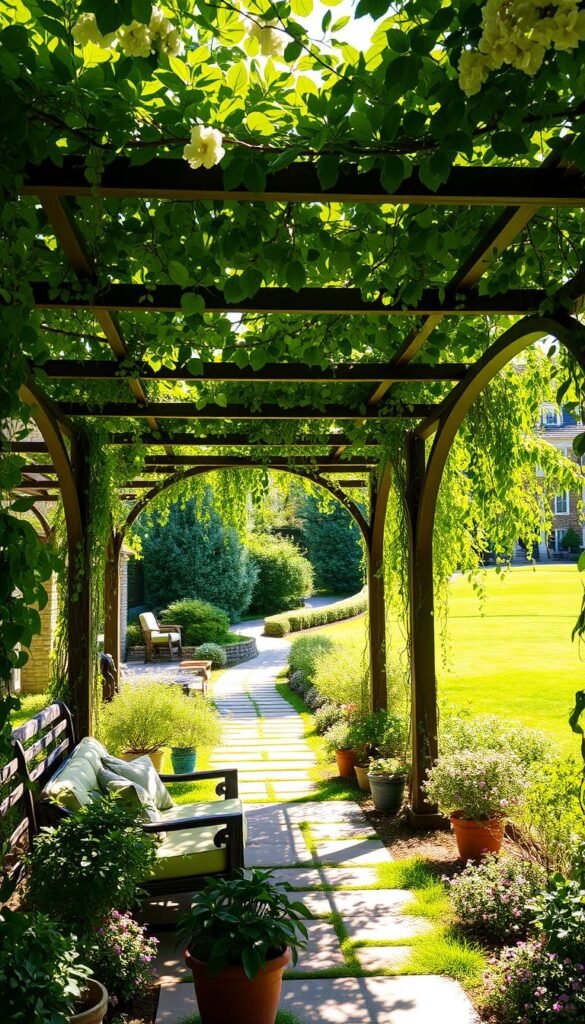Imagine an outdoor space that feels both airy and sheltered—a place where sunlight filters through slatted beams while climbing plants weave natural artwork overhead. This is the magic of pergolas, designed to merge practical sun protection with striking visual appeal. As landscape expert Amber Freda notes, these structures balance function and style, creating shaded seating areas while elevating your yard’s ambiance.
Unlike flimsy umbrellas or temporary sails, pergolas offer permanent solutions that withstand wind and weather. They frame your outdoor living area with vertical lines and open lattices, blending seamlessly into gardens or patios. Whether you prefer rustic cedar or modern metal designs, these shade providers adapt to your aesthetic vision.
You’ll love how they define spaces without closing them off. A well-placed structure becomes an outdoor dining room by day and a starlit lounge by night. Add string lights or let vines cascade across the beams—customization is effortless. Plus, built-in stability means no more chasing blown-over canopies during summer storms.
From supporting flowering plants to integrating subtle lighting, pergolas grow with your needs season after season. They’re not just shade sources—they’re experience enhancers that turn ordinary yards into curated retreats. Ready to reimagine your outdoor living? Let’s explore how these versatile designs work for you.
Embracing Outdoor Living with a Pergola
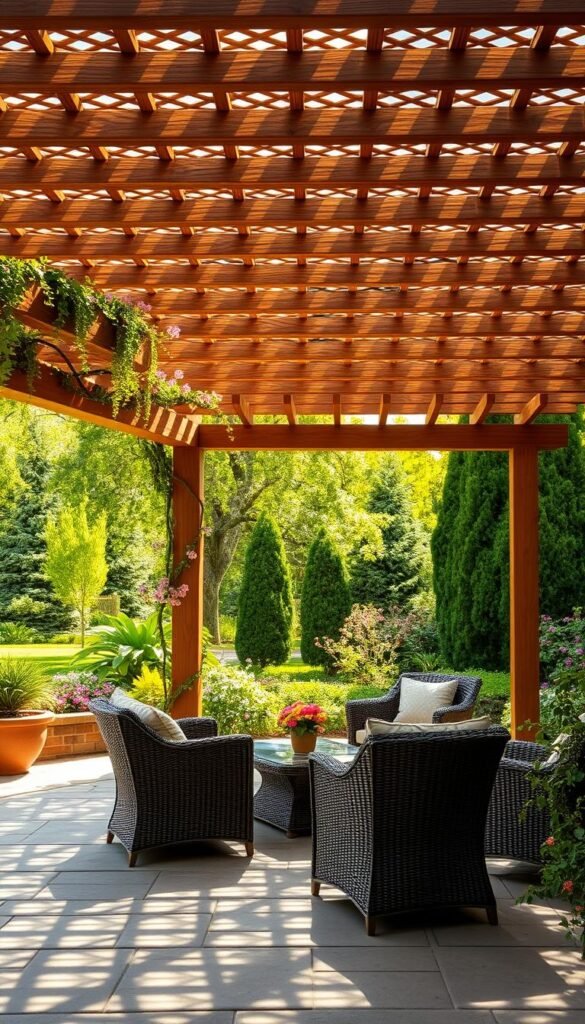
Picture your backyard transformed into a cozy yet open-air lounge where morning coffee flows into sunset gatherings. A pergola isn’t just a shade provider—it’s a bridge between your indoor comforts and the freedom of nature. Take inspiration from a historic Texas renovation by Lake|Flato architects, where matching floor tiles and a vine-draped structure merged a kitchen with a pool area, proving these designs are true extensions of your home.
Where Form Meets Function
Your pergola serves dual roles: filtering harsh sun while adding vertical intrigue. As designer Bunny Williams puts it,
“To feel the space and to really connect you to the sky, I love height.”
This elevation isn’t just visual—it defines zones for dining, lounging, or gardening without walls.
Blurring Boundaries, Expanding Space
By mirroring materials like indoor flooring or paint colors, your structure becomes a natural part of your living area. Imagine hosting dinners under a retractable canopy or unwinding beneath climbing jasmine—all while maintaining airflow and sightlines. For more creative pergola ideas, explore designs that balance openness with intimacy.
Whether framing a fire pit or supporting string lights, these adaptable features make every season feel like an invitation. They’re not just about shelter—they’re about crafting moments where your outdoor space feels as intentional as your favorite room indoors.
Unique Designs for Maximizing Shade and Style
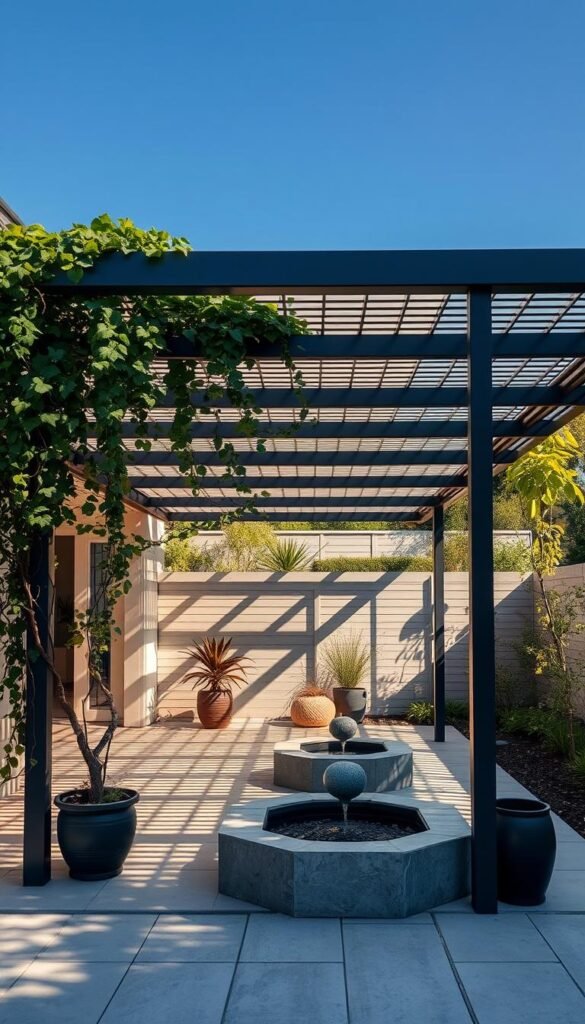
Your patio becomes a year-round retreat when modern engineering meets artistic design. Today’s solutions blend adjustable coverage with sleek aesthetics, turning basic structures into multifunctional hubs.
Modern Retractable Canopies and Shade Sails
Retractable canopies let you control sunlight like a dimmer switch. With a simple remote, adjust fabric coverage from full sun to complete shade. These systems work seamlessly on attached or freestanding structures.
Shade sails add bold geometry to your space. Their tensioned fabric creates cooling pockets while serving as colorful art installations. Architect David Baker notes:
“Dynamic shapes transform passive shading into active design statements.”
| Feature | Retractable Canopy | Shade Sail |
|---|---|---|
| Adjustability | Full range | Fixed angles |
| Installation | Motorized | DIY-friendly |
| Visual Impact | Subtle integration | Bold focal point |
PowerGazebo and Custom Seating Areas
PowerGazebo systems turn your structure into a sustainable powerhouse. Integrated solar panels charge devices while illuminating seating areas after dark. The weather-resistant frames withstand rain and UV exposure.
Pair these tech-forward features with built-in benches or modular lounge chairs. You’ll create zones perfect for brunches or solo relaxation—all under consistent weather protection.
Incorporating Natural Elements with Climbing Plants
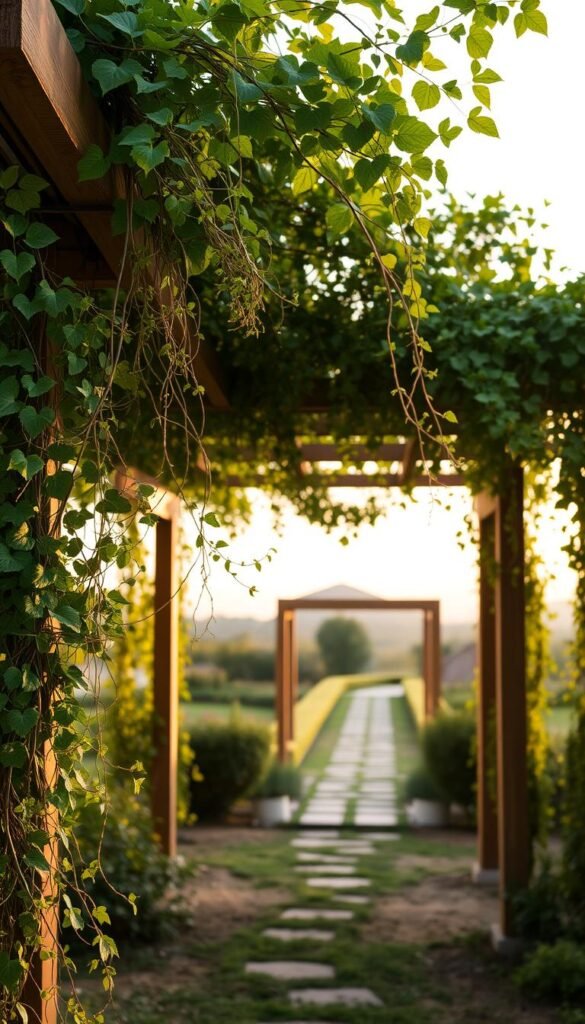
Envision a living canopy where leaves dance in the breeze and blossoms scent the air. Climbing plants turn functional structures into dynamic extensions of your landscape, blending shade with organic artistry. Vines like jasmine or clematis transform rigid beams into soft, textured focal points while cooling your seating areas naturally.
Growing Your Green Sanctuary
Choose fast-growing varieties suited to your region for quick coverage. In dry climates, bougainvillea thrives with minimal water, while ivy adapts to shaded Northeast gardens. Landscape designer Margie Grace advises:
“Layer flowering and foliage species for multi-season impact—think spring blooms paired with autumn berries.”
Train plants using lightweight trellis panels or twine guides. Reese Witherspoon’s L.A. terrace proves even busy homeowners can enjoy lush results—her self-clinging star jasmine requires only annual pruning.
Dense options like trumpet vine create natural privacy screens without blocking breezes. For dappled shade, pair wisteria with airy ferns at the base. You’ll love how climbing elements evolve daily, offering new textures and colors as they mature.
Maintenance stays simple with self-attaching varieties. Once established, these green partners need only seasonal care, letting you relax under their ever-changing canopy. Your pergola becomes a living sculpture that deepens its connection to nature year after year.
Garden Pergola Ideas for Combining Shade, Structure, and Beauty
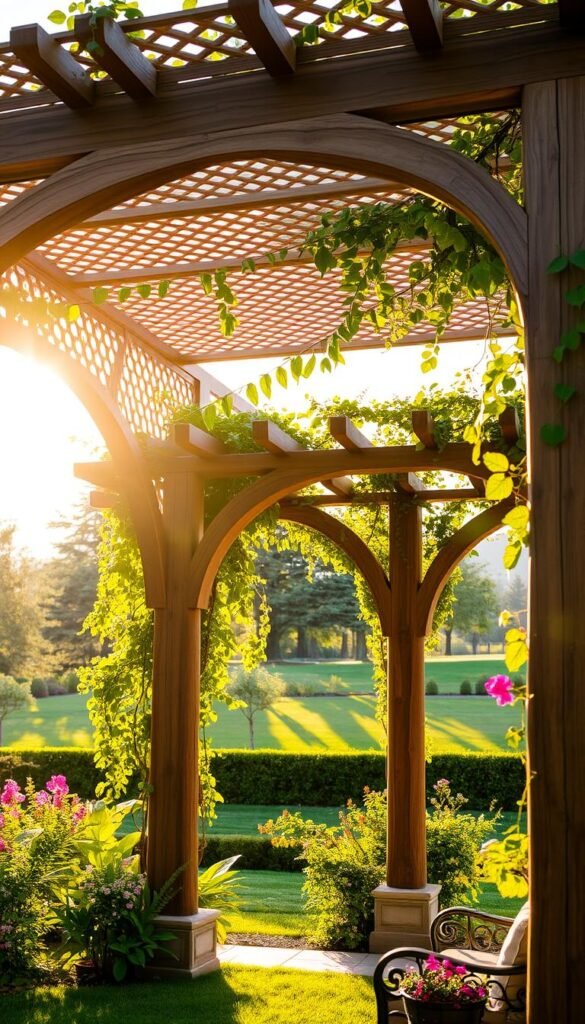
Think of your yard as a blank canvas where designs meet practicality. The right structure becomes more than shade—it’s a reflection of your lifestyle. Whether you’re hosting summer barbecues or craving a quiet reading nook, flexibility and aesthetics work hand in hand.
Inspiring Concepts to Transform Your Outdoor Space
Start by matching your needs to local weather patterns. In sunny regions, angled slats or retractable shades prevent glare while allowing airflow. For rainy climates, consider waterproof polycarbonate panels paired with climbing ivy. As designer Nate Berkus observes:
“The best spaces solve problems without shouting about it.”
Material choices also shape your experience. Cedar offers rustic warmth, while powder-coated aluminum resists humidity in coastal areas. Want a tropical vibe? Try bamboo beams with sheer drapes that flutter in the breeze.
Multipurpose designs maximize small yards. Attach planter boxes to posts for herbs or flowers, or hang pendant lights above seating areas. One homeowner in Arizona even built a retractable screen system for movie nights under their pergola.
Seasonal adaptability keeps your space relevant year-round. Swap summer vines for winter-friendly evergreens, or add removable side panels during chilly months. For evening ambiance, weave fairy lights through beams—a trick that pairs perfectly with water features after sunset.
Remember: your structure should complement, not compete. A minimalist metal frame might anchor a modern patio, while curved wooden arches soften formal gardens. Let your landscape’s personality lead the way.
Choosing the Right Materials: Wood, Aluminum, and More
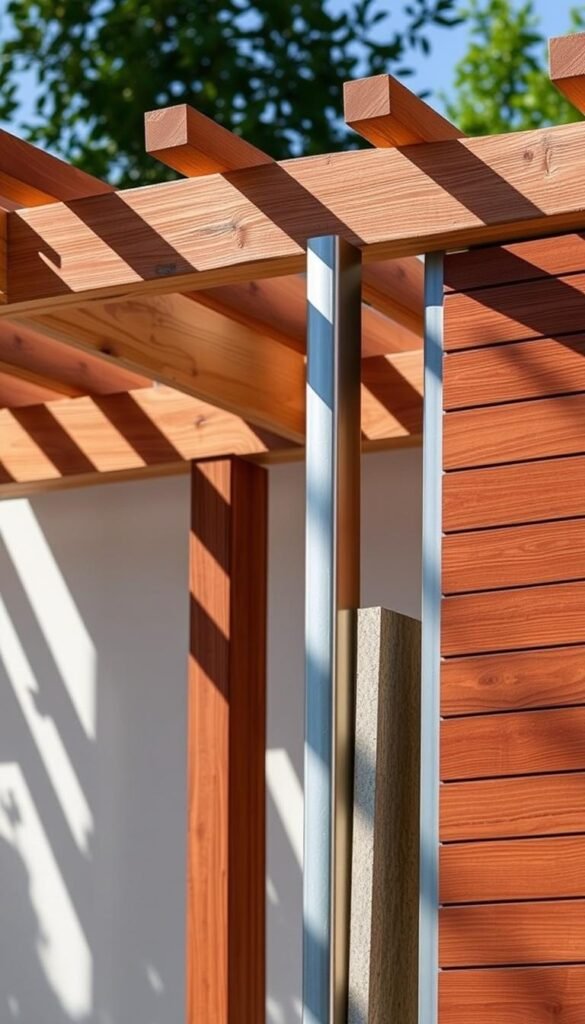
What separates a fleeting trend from a lasting outdoor feature? Your material selection acts as the foundation—literally—for how your structure performs and ages. While aesthetics matter, durability and climate compatibility determine whether your investment becomes a seasonal star or year-round retreat.
Benefits of Traditional vs. Modern Materials
Natural wood brings warmth and customization potential. Cedar develops a silvery patina over time, while acrylic-painted poplar maintains crisp white finishes. Landscape architect Janice Parker observes:
“Wood invites craftsmanship—carved details or custom stains let you mirror architectural elements from your home.”
Modern aluminum pergolas counter with weather resistance. Their powder-coated frames won’t warp or splinter, ideal for coastal areas. Prefab kits often use lightweight metals, simplifying DIY assembly compared to bulkier wooden posts.
Consider structural needs early. Pressure-treated lumber supports heavy climbing plants, while slim aluminum beams pair better with retractable shades. For a timeless garden look, blend materials—think cedar columns with metal lattice accents.
Maintenance tips:
- Seal wood annually to prevent cracking
- Wipe aluminum with mild soap to retain sheen
- Match fasteners to your primary material
Your climate dictates the best pergola option. Humid regions favor rot-resistant choices, while arid zones benefit from UV-stable composites. Remember: the right mix of materials ensures your space evolves gracefully alongside your lifestyle.
Enhancing Functionality with Outdoor Curtains and Blinds
What if your outdoor oasis could adapt to your needs as effortlessly as your living room? Outdoor curtains and bamboo blinds transform static structures into dynamic spaces, balancing shade and style while responding to shifting sun angles. These additions turn your pergola into a chameleon—airy by day, cozy by night.
Tips for Integrating Curtains and Bamboo Blinds
Sheer curtains let breezes flow while softening afternoon glare. For evening privacy, choose water-resistant fabrics in bold hues that pop against natural wood or metal. As designer Sheila Bridges advises:
“Layer textures—pair flowing linens with woven bamboo—to create depth without clutter.”
Bamboo blinds offer earthy charm with built-in UV protection. Their natural fibers age gracefully, developing a patina that blends with outdoor settings. Install them on sliding tracks for easy adjustment—perfect for creating instant shade zones during peak sunlight.
| Feature | Curtains | Bamboo Blinds |
|---|---|---|
| Light Control | Adjustable opacity | Fixed filtering |
| Maintenance | Machine-washable | Wipe clean |
| Style Impact | Soft, flowing | Textured, organic |
Retractable canopy systems take adaptability further. Pair motorized roofs with side curtains to create all-weather shelters. You’ll love how these options extend your space’s usability—hosting summer brunches or autumn dinners becomes effortless.
For smaller areas, consider corner-mounted curtains that maximize coverage without overwhelming the structure. Match tie-back hardware to your pergola’s finish—brass accents complement cedar, while powder-coated hooks align with modern metals. The right option turns functional elements into design statements.
Innovative Roof Options: Thatched, Louvered, and Fixed Designs
Imagine adjusting your shade with the twist of a knob or enjoying rain protection without losing airflow. Your pergola’s roof isn’t just functional—it’s the finishing touch that elevates your outdoor experience. Modern designs let you balance openness with shelter, adapting to weather changes and personal preferences effortlessly.
Customizing Your Pergola with Various Roof Styles
Thatched roofs bring rustic charm, perfect for tropical-inspired spaces. Their natural fibers create textured ceilings that pair beautifully with wood posts. For precision control, louvered systems let you tilt blades to direct sunlight or block showers. Fixed polycarbonate panels offer permanent coverage while maintaining brightness—ideal for rainy climates.
Explore versatile roof styles that match your lifestyle. Aluminum options resist corrosion, while glass panels add sleek transparency. Want greenery overhead? Train climbing plants across lattice beams for living shade that evolves with the seasons.
How to Achieve Optimal Sun and Rain Protection
Angle fixed roofs to deflect summer glare while inviting winter light. Waterproof louvers channel rain away from seating areas, keeping gatherings dry. Pair metal posts with retractable fabric canopies for quick adjustments during unpredictable weather.
Durable materials like powder-coated steel ensure years of use without warping. For natural cooling, let vines weave through beams—their leaves filter sunlight while softening harsh lines. Your roof becomes both shield and showcase, blending practicality with personality.

